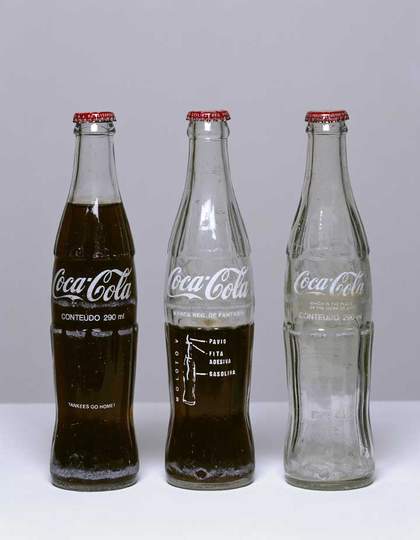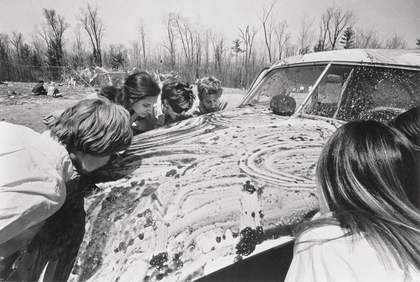
Cildo Meireles
Insertions into Ideological Circuits: Coca-Cola Project 1970
Tate
© Cildo Meireles
When Brazilian artist Cildo Meireles produced his Insertions into Ideological Circuits: Coca-Cola Project 1970 (Tate T12328) in Rio de Janeiro, he was looking for a form that could both capture the experience of life under dictatorship and push back against its oppressive constraints. Meireles designed Insertions into Ideological Circuits: Coca-Cola Project to maximize effect while minimizing his own risk of being identified; the work consisted in altering reusable Coca-Cola bottles by adding questions, slogans or illustrations in a white font that mimicked the bottle’s brand inscriptions. Three examples of these bottles are pictured above, each with a different furtive missive. The bottle on the left bears the phrase, ‘Yankees go home!’; the one in the middle, a labelled diagram of a Molotov cocktail; on the right, the more philosophical query, ‘Which is the place of the work of art?’ Despite the dramatic provocations offered, these modifications are subtle – practically invisible when the bottle is empty; then legible when filled. Meireles created over 1,000 such bottles, releasing them back into circulation to be passed between untold numbers of people along the circular route between the Coca-Cola bottling plant and the marketplace.1
Meireles devised this circulating artwork because of the political climate in which he was working. A few years earlier, on 31 March 1964, the Brazilian Armed Forces ousted democratically elected President João Goulart in a coup d’état, initiating a period of military dictatorship that would last until 1985.2 By 1968 the new regime had consolidated authority and restricted the bounds of permissible expression with the notorious Ato Institucional #5 (Institutional Act #5), which revoked political and civil rights and even sanctioned torture.3 Artists living under this constant threat of violent censorship – but without even the dubious benefit of specific guidelines as to what would and would not be tolerated by the military regime – had to develop new strategies for making socially significant art. For Meireles this meant putting the work of art quite literally in the audience’s hands.
This intersection of readymade sculpture, political exigency and audience participation raises a host of questions for a study of performance at Tate. Critics and scholars have tended to focus on the work’s potential for heroic intervention, the way the bottles quietly and in circumstances of fearsome repression nevertheless managed publicly to voice opposition to the regime. We might call this the ‘message on a bottle’ approach to Insertions into Ideological Circuits: Coca-Cola Project. Curator and critic Okwui Enwezor offered an eloquent example of this perspective in 2008: ‘Insertions thus operated at the level of social infiltration of the State’s ideological circuits … and the circuits of consumption controlled by global capital and American imperialism … as a means of reclaiming a public realm that was subordinated to the two forces’.4 The Coca-Cola bottle symbolised a dual subjugation forced on the Brazilian populace. First, the top-down model of government by dictatorship finds a formal echo in the bottles’ system of distribution – every bottle gets filled with the same contents at a single point of origin. Second, those contents spread the message of capitalist hegemony. Coca-Cola is an American product, closely identified with American culture, which gestured to the USA’s global aims in Brazil and their backing of the coup d’état. As Meireles put it, ‘the container always carries with it an ideology’.5 The ‘message on a bottle’ perspective understandsInsertions into Ideological Circuits: Coca-Cola Project as interventions into a circuit of consumption capable of disrupting normal activities by bringing to light subterranean facts or relations. Operating in conditions of fierce repression, the bottle acted as a clarion call, alerting its bearer to the need to take action.
Considering Insertions into Ideological Circuits: Coca-Cola Project in this way, it is hard to imagine what value these three bottles, when put on display at Tate, might present to museum-goers aside from their ability to gesture toward a distant place and time. Indeed, Enwezor suggested that in a museum the project offers only the ‘carcass of the artistic past’.6 This suspicion has plagued many time-based works that depend on action in a given moment. It is worth noting that such criticism is here levied in relation to a set of objects rather than a durational performance, but still the question remains: if we were not ‘there’, how can we really experience the work? Asking this question of Meireles’s project opens it to later audiences, but also develops a more sensitive reading of how it functioned in its original context. Imagining that an inscribed bottle could provoke a psychic rupture and initiate political dissent might seem already to engage the language of performance, dependent as it is on the object’s agency. Such a notion, however, seems premised upon the notion that Brazilians were unaware of their own subjection before the bottle told them about it and that, moreover, the context in which the work and the audience found themselves could be identified as a single, unitary thing – unchanging and experienced identically by all subjects in the ideological circuit.
The discourse of performance, however, highlights how context cannot be taken for granted in this way, but is constantly produced by people, their histories and their engagement with the world around them. This shifting ground was described by the philosopher J.L. Austin as ‘performative’. Performativity describes how linguistic events that effect realities (rather than describing them) are rooted in the social codes and contexts in which they participate. Saying ‘I do’ only entails marriage when the context in which it is uttered endows the phrase with that power. Likewise, the phrase ‘Yankees go home!’ would only be met by assent if the bottle’s bearer already felt the need for dissent.
Meireles’s project participated in this performative realm by making the composition of the artwork, as well as meaning and effect, a product of reception. Every encounter with a bottle created a unique experience; each of these instances was unrepeatable because it was (and is) situated in one moment with one person. Tempting though it may be, it is impossible to say whether Insertions into Ideological Circuits: Coca-Cola Project interrupted a top-down flow of information – probably sometimes it did and sometimes it did not. No work of art has a guaranteed efficacy; to understand performativity is to acknowledge this reality.
But then the ideology at stake here was never really in the bottle. Rather, the ideological circuit under investigation existed between people. Insertions into Ideological Circuits: Coca-Cola Project, then, was not about the message, it was about the circuit. Performance was not what happened when the bottles supposedly changed people’s minds, but what happened when people interacted with the bottles to articulate their own sense of social reality – this is what opens the work for future instances of reception. The bottles prompted their interlocutors to stake a position in relation to the slogans they offered. At the same time, the handy formal and conceptual simplicity of the to-and-fro circulation of the bottles meant that people had to envision themselves within a network of power relations. The bottles’ performativity consisted in asking consumers to articulate their own position within a dispersed social field, to confront their own sense of social reality in conversation with the bottles’ and to know that other people would be doing this same thing.
Conceiving of Insertions into Ideological Circuits: Coca-Cola Project in terms of performance entails shifting the emphasis away from the message that supposedly resided in, or on, the work itself to the ways the object, both in and as circulation, traced a collective situation, rendering it in human scale through a calculated mode of dissemination. Meireles’s work shows us that ideological circuits – the opinions, habits and assumptions we exercise reflexively – are reproduced on a daily basis. This subtle reorientation not only opens new ways of understanding the work’s historical operation, but offers present viewers a tool and a metaphor for understanding our own positions within larger circuits of exchange and meaning.

